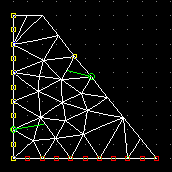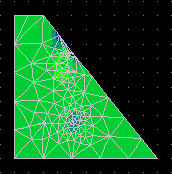|
How a crack grows is called "crack propagation" and this takes into account
when a crack can start to grow, how far it grows, and what direction it goes
in.
So when can it grow? Well there are two ways to look at it. First, from the
point of view of the stress intensity factor, KI. The material
resists cracking with everything it has, which is called its fracture
toughness. (KIc, which was mentioned before, stands for fracture toughness. It's said "K
one c".)
The crack can grow when its stress intensity factor (sif) reaches the fracture
toughness of the material:
KIc=KI
The other way to look at when a crack can grow is the energy way, which was
also mentioned before. When a crack is formed,
new surfaces are also formed, along the edges where the material has split
apart. The material has to have enough energy to create these new surfaces or
it will not crack. If G is the energy necessary for the crack to grow and
R is the material's resistance to crack growth, the condition for a crack to
grow is:
G = R
But once the crack has grown, will it keep growing? Things change once a crack
has grown. The resistance of the material may have gone up or down; the
energy necessary to grow the crack may also have gone up or down. In order
for the crack to continue growing each time, the change in energy must equal
the change in resistance. If the change in energy is less than the change in
resistance, then the crack will not grow any more unless more force is
applied. If the change in energy is greater than the change in resistance,
there will be unstable crack growth. In this case the crack may grow until
the structure fails.
|
 Check out this movie of a crack at the molecular level!
Check out this movie of a crack at the molecular level!
(ref: F.F.Abraham et al)
But if the material is being loaded in more than one mode, this isn't true. If the material is being
pushed and pulled in more than one direction, the crack may have different
choices on which direction to go in. There are a couple different theories on
which way the crack will go.
|
|
Once the crack doesn't have enough energy to grow any more, it stops, or
arrests. Hopefully, the structure hasn't failed by then.
Cracking your model in a simulation
| At this stage of the game, computer simulations
for crack growth can figure out how the crack will grow, but not how or where
it will start. So you have to tell the program where the crack starts and
then it can do the rest.
Here is an image of a model with an initial cracks on both the left hand edge
and the right hand edge (cracks are green lines). The program which will
analyzed this model can only handle cracks which start from the outside of the
structure.
|

|

|
This is what the model looks like after the program has
grown the crack. The tips of the cracks have moved to where
you see the blue patches. |
So what is this computer program
that does cracking simulations? |




